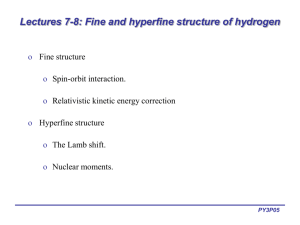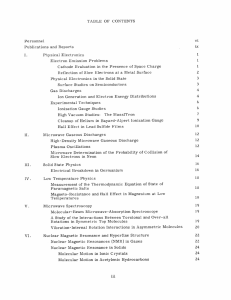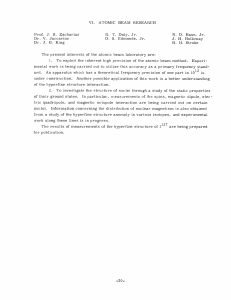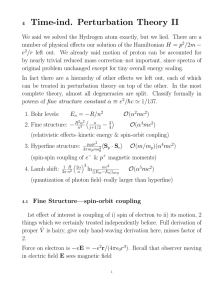Lecture 7: Fine and hyperfine structure of one
advertisement
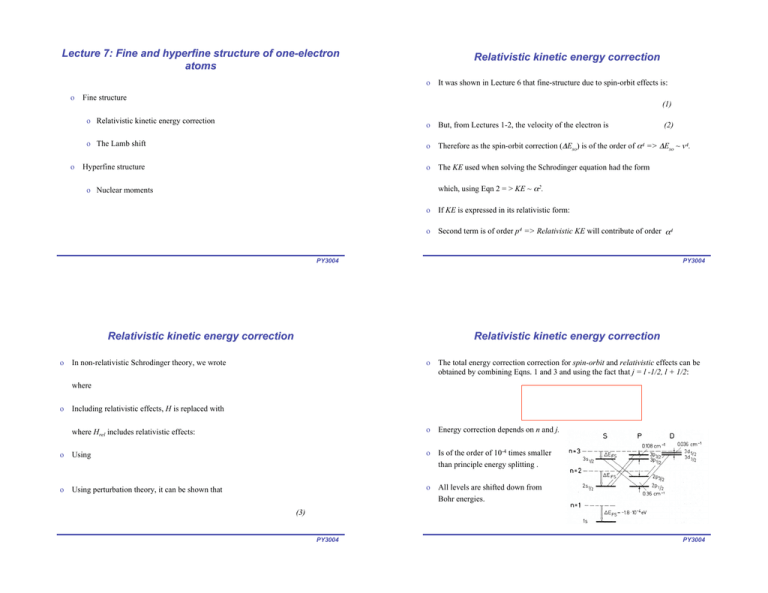
Lecture 7: Fine and hyperfine structure of one-electron atoms Relativistic kinetic energy correction o o (1) o Relativistic kinetic energy correction o It was shown in Lecture 6 that fine-structure due to spin-orbit effects is: Fine structure o But, from Lectures 1-2, the velocity of the electron is o The Lamb shift o Therefore as the spin-orbit correction (!Eso) is of the order of "4 => !Eso ~ v4. Hyperfine structure o The KE used when solving the Schrodinger equation had the form which, using Eqn 2 = > KE ~ "2. o Nuclear moments o If KE is expressed in its relativistic form: o Second term is of order p4 => Relativistic KE will contribute of order "4 PY3004 PY3004 Relativistic kinetic energy correction o (2) Relativistic kinetic energy correction In non-relativistic Schrodinger theory, we wrote o The total energy correction correction for spin-orbit and relativistic effects can be obtained by combining Eqns. 1 and 3 and using the fact that j = l -1/2, l + 1/2: where Hrel includes relativistic effects: o Energy correction depends on n and j. o Using o Is of the order of 10-4 times smaller than principle energy splitting . o Using perturbation theory, it can be shown that o All levels are shifted down from Bohr energies. where o Including relativistic effects, H is replaced with (3) PY3004 PY3004 Gross and fine structure of hydrogen atom o o o Fine structure of hydrogen For H-atom, the spin-orbit and relativistic corrections are comparable in magnitude, but much smaller than the gross structure. Gross structure determined by En from Schrödinger equation. As En = -Z2E0/n2, where E0 = 1/2"2mc2, we can write Gives the energy of the gross and fine structure of the hydrogen atom. o Energy correction only depends on j, which is of the order of 10-4 times smaller that the principle energy splitting. o All levels are shifted down from the Bohr energies. o For every n>1 and l, there are two states corresponding to j = l ± 1/2. o States with same n and j but different l, have the same energies (does not hold when Lamb shift is included). i.e., are degenerate. o Using incorrect assumptions, this fine structure was derived by Sommerfeld by modifying Bohr theory => right results, but wrong physics! PY3004 PY3004 Fine structure: Lamb shift Fine structure: Lamb shift o Spectral lines can give info on nucleus via isotope shift and hyperfine structure. 1. Excite H-atoms to 22S1/2 metastable state by e- bombardment. Forbidden to spontaneuosly decay to 12S1/2 optically. o According to Schrödinger and Dirac theory, states with same n and j but different l are degenerate. However, Lamb and Retherford showed in 1947 that 22S1/2 (n = 2, l = 0, j = 1/2) and 22P1/2 (n = 2, l = 1, j = 1/2) of H-atom are not degenerate. 2. Cause transitions to 22P1/2 state using tunable microwaves. Transitions only occur when microwaves tuned to transition frequency. These atoms then decay emitting H" line. o Experiment proved that even states with the same total angular momentum J are energetically different. 3. Measure number of atoms in 22S1/2 state from H-atom collisions with tungsten (W) target. When excitation to 22P1/2, current drops. 4. Excited H atoms (22S1/2 metastable state) cause secondary electron emission and current from the target. Dexcited H atoms (12S1/2 ground state) do not. PY3004 PY3004 Fine structure: Lamb shift o Experiment showed that the 2P1/2 state is slightly lower than the 2S1/2 state. o The Lamb shift is due to the quantised EM field - a quantum electrodynamic effect. o Using "E"t # mc "t $ h the range over which force operates is: ! o Hyperfine structure: Nuclear moments 2 The proton-electron force is slightly weakened when the electron is very close to nucleus => causes the 2S1/2 level to be higher in energy than 2P1/2 level. o Hyperfine structure can also result from magnetic interaction between the electron’s total angular momentum (J) and the nuclear spin (I). o Angular momentum of electron creates a magnetic field at the nucleus which is proportional to J. o Interaction energy is therefore o Magnitude is very small as nuclear dipole is ~2000 smaller than electron (µ~1/m). o Hyperfine splitting is about three orders of magnitude smaller than splitting due to fine structure. PY3004 PY3004 Hyperfine structure: Nuclear moments o o o Hyperfine structure: Nuclear moments Like electron, the proton has a spin angular momentum and an associated intrinsic dipole moment o The proton dipole moment is weaker than the electron dipole moment by M/m ~ 2000 and hence the effect is small. Total angular momentum including nuclear spin, orbital angular momentum and electron spin is where a is the hyperfine structure constant. o E.g., consider the ground state of H-atom. Nucleus consists of a single proton, so I = 1/2. The hydrogen ground state is the 1s 2S1/2 term, which has J = 1/2. Spin of the electron can be ! parallel (F = 1) or antiparallel (F = 0). Transitions between these levels occur at 21 cm (1420 MHz). o For ground state of the hydrogen atom (n=1), the energy separation between the states of F = 1 and F = 0 is 5.9 x 10-6 eV. where o o The quantum number f has possible values f = j + 1/2, j - 1/2 since the proton has spin 1/2. Hence every energy level associated with a particular set of quantum numbers n, l, and j will be split into two levels of slightly different energy, depending on the relative orientation of the proton magnetic dipole with the electron state. PY3004 The energy splitting of the hyperfine interaction is given by F=1 F=0 21 cm radio map of the Milky Way PY3004 Gross, fine and hyperfine structure of hydrogen Selection rules for transitions o PY3004 Summary of atomic energy scales o Gross structure: o Covers largest interactions within the atom: o Kinetic energy of electrons in their orbits. o Attractive electrostatic potential between positive nucleus and negative electrons o Size of these interactions gives energies in the 1-10 eV range and upwards. o Determine whether a photon is IR, visible, UV or X-ray. o Fine structure: o Spectral lines often come as multiplets. E.g., H" line. => smaller interactions, called spin-orbit interaction. o Relativistic effects have similar magnitude. o Hyperfine structure: o Fine-structure lines are split into more multiplets. o Caused by interaction between electron spin and nucleus spin. o E.g., 21-cm line in radio astronomy. PY3004 Selection rules determine the allowed transitions between terms. PY3004
